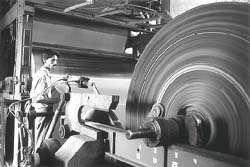Greener Shades
 representatives of India's pulp and paper industry met the Green Rating Project ( grp ) unit of the Centre for Science and Environment, New Delhi, to take stock of their environmental performance more than one year after the release of the first ever environmental rating of its kind in the country. On September 26, 2000, the corporate heads of the sector and cse got together to assess the developments in the industry's perception of the rating process. Various companies reported the changes they had engineered towards cleaner operations and greater efficiency as a result of the rating.
representatives of India's pulp and paper industry met the Green Rating Project ( grp ) unit of the Centre for Science and Environment, New Delhi, to take stock of their environmental performance more than one year after the release of the first ever environmental rating of its kind in the country. On September 26, 2000, the corporate heads of the sector and cse got together to assess the developments in the industry's perception of the rating process. Various companies reported the changes they had engineered towards cleaner operations and greater efficiency as a result of the rating.
In 1999 the grp unit asked the paper and pulp industry of India to bare all and come clean on its environmental record. Commendably, the industry responded positively. The grp unit of cse rated the industry for its environmental performance. The objective was two-fold. One, to create a system where a kind of performance anxiety could drive the companies into doing better. Two, to raise awareness level among the top managers of the industry regarding corporate environmental responsibilities. As Chandra Bhushan, coordinator of the grp unit of cse says, " grp does not intend to criticise the industry but to encourage it towards greater community participation.'
Two years of hard labour, detailed investigation and comprehensive exchange of information between the industry members and cse led to the first ever ratings of the kind in India.
Usually, one would hear stories of the casual and callous attitude of the corporate world towards environmental concerns. The pulp and paper industry was said to be especially notorious for the lack of transparency about environmental matters. But the industry, after initial hesitation, had shown a healthy maturity in divulging information and interacting with honesty.
The assessment On July 18, 1999, the rating was released and presented to the president the next day. Supported by the Union ministry of environment and forests and the United Nations Development Programme, the entire process involved 18 months of detailed analysis, research, investigation and field studies (see box: The first time).
It would have been a futile exercise had cse left the process at that. But the rating process is visualised as a continuing one. In 2001 the industry will be rated again. Therefore, the grp unit felt the need to improve the rating process as well as assess what difference, if any, the previous rating had made to the industry's approach.
Anil Agarwal, director of cse, told the assembled that the target was not to meet domestic standards. "We must know where we stand with respect to global standards,' he said. Quite a few units presented information exhibiting that the industry is moving in the right direction and the rating process deserves some credit. "The project convinced us into adopting cleaner technology for our new pulping project,' says S Raghuveer, manager in itc -Bhadrachalam Paperboards Limited, Andhra Pradesh. cse believes grp creates a
